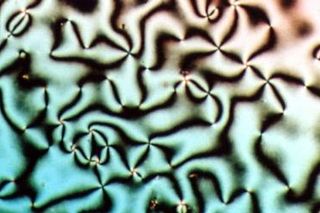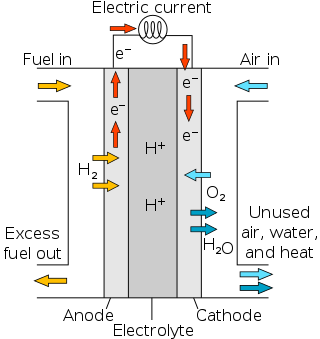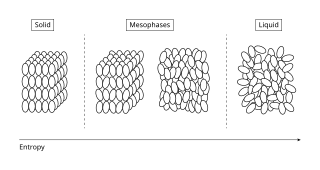Related Research Articles

In chemistry, a hydrogen bond is primarily an electrostatic force of attraction between a hydrogen (H) atom which is covalently bonded to a more electronegative "donor" atom or group (Dn), and another electronegative atom bearing a lone pair of electrons—the hydrogen bond acceptor (Ac). Such an interacting system is generally denoted Dn−H···Ac, where the solid line denotes a polar covalent bond, and the dotted or dashed line indicates the hydrogen bond. The most frequent donor and acceptor atoms are the period 2 elements nitrogen (N), oxygen (O), and fluorine (F).

Liquid crystal (LC) is a state of matter whose properties are between those of conventional liquids and those of solid crystals. For example, a liquid crystal can flow like a liquid, but its molecules may be oriented in a common direction as in a solid. There are many types of LC phases, which can be distinguished by their optical properties. The contrasting textures arise due to molecules within one area of material ("domain") being oriented in the same direction but different areas having different orientations. An LC material may not always be in an LC state of matter.

In chemistry, a salt or ionic compound is a chemical compound consisting of an ionic assembly of positively charged cations and negatively charged anions, which results in a neutral compound with no net electric charge. The constituent ions are held together by electrostatic forces termed ionic bonds.

In physics, a state of matter is one of the distinct forms in which matter can exist. Four states of matter are observable in everyday life: solid, liquid, gas, and plasma. Many intermediate states are known to exist, such as liquid crystal, and some states only exist under extreme conditions, such as Bose–Einstein condensates and Fermionic condensates, neutron-degenerate matter, and quark–gluon plasma. For a list of exotic states of matter, see the article List of states of matter.
An electrolyte is a medium containing ions that are electrically conductive through the movement of those ions, but not conducting electrons. This includes most soluble salts, acids, and bases dissolved in a polar solvent, such as water. Upon dissolving, the substance separates into cations and anions, which disperse uniformly throughout the solvent. Solid-state electrolytes also exist. In medicine and sometimes in chemistry, the term electrolyte refers to the substance that is dissolved.

Proton-exchange membrane fuel cells (PEMFC), also known as polymer electrolyte membrane (PEM) fuel cells, are a type of fuel cell being developed mainly for transport applications, as well as for stationary fuel-cell applications and portable fuel-cell applications. Their distinguishing features include lower temperature/pressure ranges and a special proton-conducting polymer electrolyte membrane. PEMFCs generate electricity and operate on the opposite principle to PEM electrolysis, which consumes electricity. They are a leading candidate to replace the aging alkaline fuel-cell technology, which was used in the Space Shuttle.

An ionic liquid (IL) is a salt in the liquid state at ambient conditions. In some contexts, the term has been restricted to salts whose melting point is below a specific temperature, such as 100 °C (212 °F). While ordinary liquids such as water and gasoline are predominantly made of electrically neutral molecules, ionic liquids are largely made of ions. These substances are variously called liquid electrolytes, ionic melts, ionic fluids, fused salts, liquid salts, or ionic glasses.

A proton conductor is an electrolyte, typically a solid electrolyte, in which H+ are the primary charge carriers.
A proton-exchange membrane, or polymer-electrolyte membrane (PEM), is a semipermeable membrane generally made from ionomers and designed to conduct protons while acting as an electronic insulator and reactant barrier, e.g. to oxygen and hydrogen gas. This is their essential function when incorporated into a membrane electrode assembly (MEA) of a proton-exchange membrane fuel cell or of a proton-exchange membrane electrolyser: separation of reactants and transport of protons while blocking a direct electronic pathway through the membrane.
Deep eutectic solvents or DESs are solutions of Lewis or Brønsted acids and bases which form a eutectic mixture. Deep eutectic solvents are highly tunable through varying the structure or relative ratio of parent components and thus have a wide variety of potential applications including catalytic, separation, and electrochemical processes. The parent components of deep eutectic solvents engage in a complex hydrogen bonding network which results in significant freezing point depression as compared to the parent compounds. The extent of freezing point depression observed in DESs is well illustrated by a mixture of choline chloride and urea in a 1:2 mole ratio. Choline chloride and urea are both solids at room temperature with melting points of 302 °C and 133 °C respectively, yet the combination of the two in a 1:2 molar ratio forms a liquid with a freezing point of 12 °C. DESs share similar properties to ionic liquids such as tunability and lack of flammability yet are distinct in that ionic liquids are neat salts composed exclusively of discrete ions. In contrast to ordinary solvents, such as Volatile Organic Compounds (VOC), DESs are non-flammable, and possess low vapour pressures and toxicity.

A molecular solid is a solid consisting of discrete molecules. The cohesive forces that bind the molecules together are van der Waals forces, dipole–dipole interactions, quadrupole interactions, π–π interactions, hydrogen bonding, halogen bonding, London dispersion forces, and in some molecular solids, coulombic interactions. Van der Waals, dipole interactions, quadrupole interactions, π–π interactions, hydrogen bonding, and halogen bonding are typically much weaker than the forces holding together other solids: metallic, ionic, and network solids. Intermolecular interactions typically do not involve delocalized electrons, unlike metallic and certain covalent bonds. Exceptions are charge-transfer complexes such as the tetrathiafulvane-tetracyanoquinodimethane (TTF-TCNQ), a radical ion salt. These differences in the strength of force and electronic characteristics from other types of solids give rise to the unique mechanical, electronic, and thermal properties of molecular solids.
This glossary of chemistry terms is a list of terms and definitions relevant to chemistry, including chemical laws, diagrams and formulae, laboratory tools, glassware, and equipment. Chemistry is a physical science concerned with the composition, structure, and properties of matter, as well as the changes it undergoes during chemical reactions; it features an extensive vocabulary and a significant amount of jargon.

In chemistry and chemical physics, a mesophase or mesomorphic phase is a phase of matter intermediate between solid and liquid. Gelatin is a common example of a partially ordered structure in a mesophase. Further, biological structures such as the lipid bilayers of cell membranes are examples of mesophases. Mesophases with long-range positional order but no orientational order are plastic crystals, whereas those with long-range orientational order but only partial or no positional order are liquid crystals.
A network solid or covalent network solid is a chemical compound in which the atoms are bonded by covalent bonds in a continuous network extending throughout the material. In a network solid there are no individual molecules, and the entire crystal or amorphous solid may be considered a macromolecule. Formulas for network solids, like those for ionic compounds, are simple ratios of the component atoms represented by a formula unit.
Solids can be classified according to the nature of the bonding between their atomic or molecular components. The traditional classification distinguishes four kinds of bonding:
Crystallization of polymers is a process associated with partial alignment of their molecular chains. These chains fold together and form ordered regions called lamellae, which compose larger spheroidal structures named spherulites. Polymers can crystallize upon cooling from melting, mechanical stretching or solvent evaporation. Crystallization affects optical, mechanical, thermal and chemical properties of the polymer. The degree of crystallinity is estimated by different analytical methods and it typically ranges between 10 and 80%, with crystallized polymers often called "semi-crystalline". The properties of semi-crystalline polymers are determined not only by the degree of crystallinity, but also by the size and orientation of the molecular chains.
In solid-state physics, an orientational glass is a molecular solid in which crystalline long-range order coexists with quenched disorder in some rotational degree of freedom.
In materials science, cocrystals are "solids that are crystalline, single-phase materials composed of two or more different molecular or ionic compounds generally in a stoichiometric ratio which are neither solvates nor simple salts." A broader definition is that cocrystals "consist of two or more components that form a unique crystalline structure having unique properties." Several subclassifications of cocrystals exist.

Klaas Wynne is a professor in the School of Chemistry at the University of Glasgow and chair of Chemical Physics. He was previously a professor in the Department of Physics at the University of Strathclyde (1996–2010).
Jean Émile Charles Timmermans was a Belgian physical chemist and educator. He was known for the discovery of plastic crystals and the published books on physical chemistry constants and experimental data of pure solutions. He also curated the work of Belgian chemist Jean Stas. Timmermans was a member of the Brussels school of thermodynamics centered around Brussels and one of the mentors of Nobel laureate Ilya Prigogine.
References
- 1 2 3 4 5 6 Jiangshui Luo; Annemette H. Jensen; Neil R. Brooks; Jeroen Sniekers; et al. (2015). "1,2,4-Triazolium perfluorobutanesulfonate as an archetypal pure protic organic ionic plastic crystal electrolyte for all-solid-state fuel cells". Energy & Environmental Science . 8 (4): 1276–1291. doi:10.1039/C4EE02280G.
- 1 2 Jiangshui Luo; Olaf Conrad & Ivo F. J. Vankelecom (2013). "Imidazolium methanesulfonate as a high temperature proton conductor" (PDF). Journal of Materials Chemistry A . 1 (6): 2238–2247. doi:10.1039/C2TA00713D.
- ↑ Jacob C. W. Folmer; Ray L. Withers; T. R. Welberry; James D. Martin (2008). "Coupled orientational and displacive degrees of freedom in the high-temperature plastic phase of the carbon tetrabromide α-CBr4". Physical Review B. 77 (14). 144205. Bibcode:2008PhRvB..77n4205F. doi:10.1103/PhysRevB.77.144205.
- ↑ Amit Mondal; Biswajit Bhattacharya; Susobhan Das; Surojit Bhunia; et al. (2020). "Metal‐like Ductility in Organic Plastic Crystals: Role of Molecular Shape and Dihydrogen Bonding Interactions in Aminoboranes". Angewandte Chemie International Edition . 59 (27): 10971–10980. doi:10.1002/anie.202001060. PMID 32087039.
- ↑ Peter R. Sahm; Iván Egry; Thomas Volkmann, eds. (1999). Schmelze, Erstarrung, Grenzflächen. Eine Einführung in die Physik und Technologie flüssiger und fester Metalle. Berlin, Heidelberg: Springer. doi:10.1007/978-3-642-58523-4. ISBN 978-3-540-41566-4.
- ↑ Timmermans, J. (1938). "Un nouvel état mésomorphe les cristaux organiques plastiques". Journal de Chimie Physique (in French). 35: 331–344. doi:10.1051/jcp/1938350331. ISSN 0021-7689.
- ↑ A. Michils (1948). "Recherches stoechiométriques V.VIII. LA PLASTICITÉ D'UN GROUPE PARTICULIER DE CRISTAUX ORGANIQUES". Bulletin des Sociétés Chimiques Belges (in French). 57 (10–12): 575–617. doi:10.1002/bscb.19480571013.